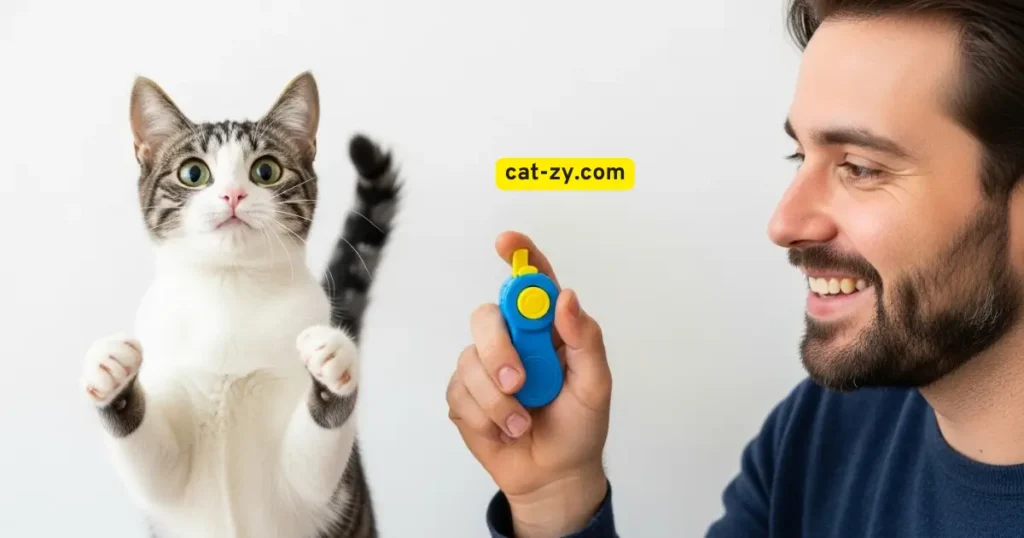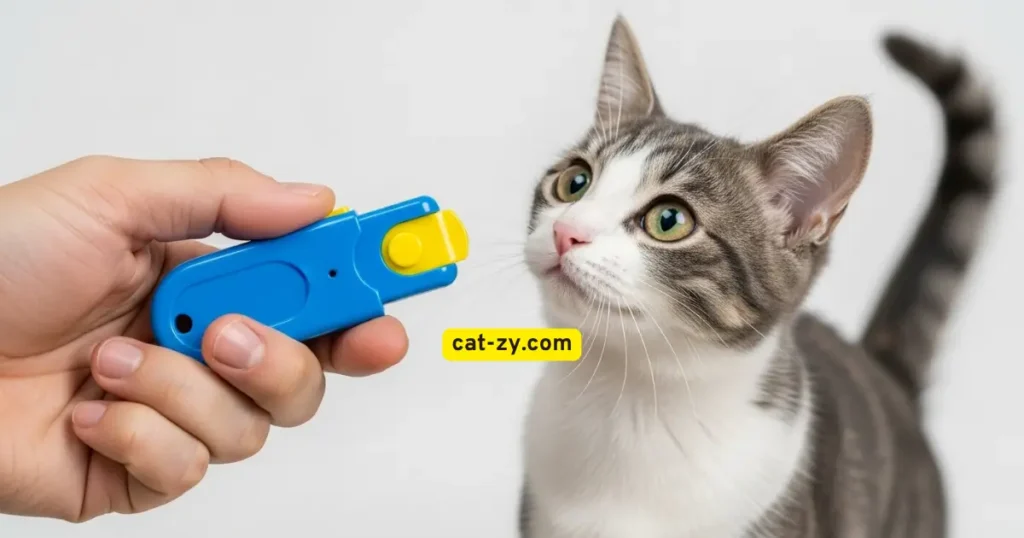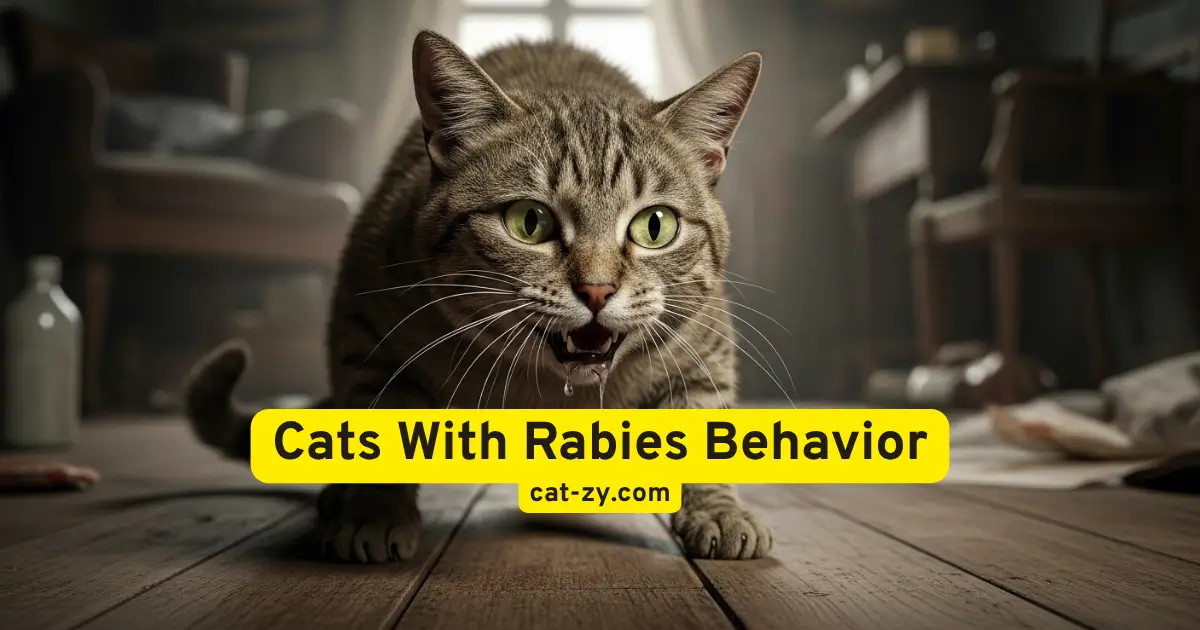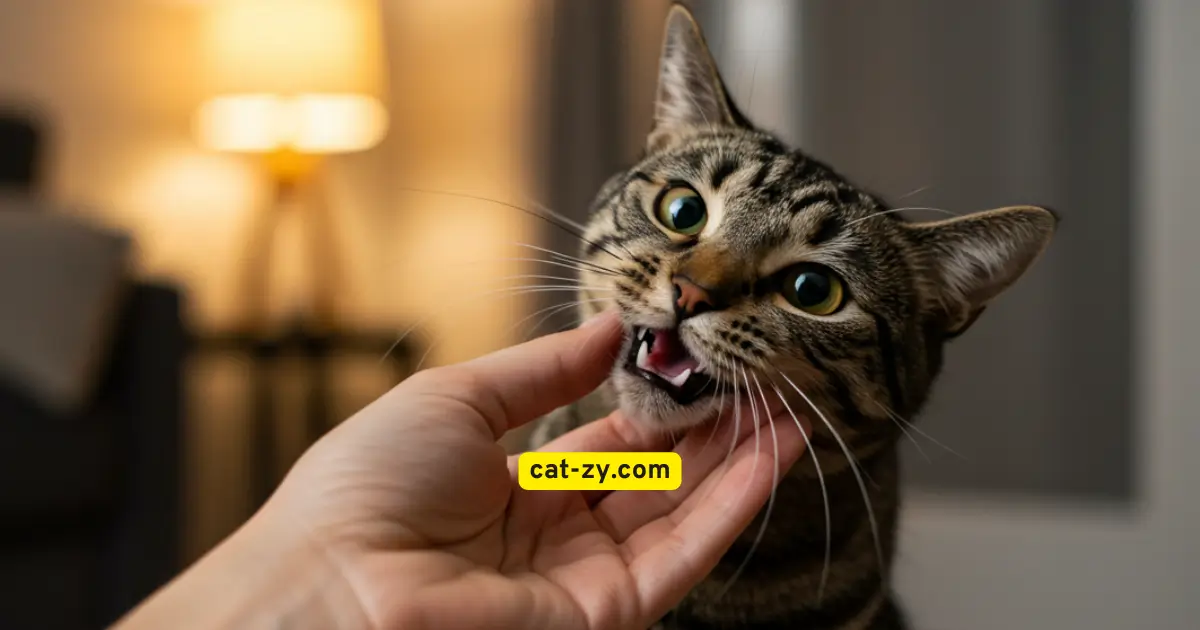Cat Clicker Training: 7 Proven Techniques to Transform Your Cat’s Behavior
Do you find it hard to understand your feline friend’s behavior? Do you want to encourage good habits and strengthen your bond with your pet? Cat clicker training is a simple, effective way to do just that.
Using a clicker to mark good behaviors and rewarding your pet can change their actions. It also improves your relationship. This method is fun and engaging for both you and your pet.
In this article, we’ll look at seven proven cat clicker training techniques. These methods can help with behavioral issues or just make your pet’s life better. They give you the tools you need to succeed.
Table of Contents
Understanding the Science Behind Cat Clicker Training
The science of cat clicker training is based on feline psychology and positive reinforcement techniques. It uses the cat’s behavior to teach them new actions. This makes it a great way to train cats.
How Clicker Training Works with Feline Psychology
Cat clicker training links a sound—the click—to a treat. This tells your cat they did something right. By knowing feline psychology, you can train your cat in a way that fits their nature.
Cats love sound and rewards, making the clicker very effective. It gives them instant feedback.
The clicker is a precise marker for your cat. It shows them exactly what they did right. This makes learning faster for them.
The Benefits of Positive Reinforcement for Cats
Positive reinforcement rewards good behavior with treats. It’s great for cats because it builds trust and encourages natural actions. It also avoids fear or stress.
Positive reinforcement does more than just train cats. It makes your relationship with them better. It makes cats more interactive and can solve problems like boredom or stress.
Essential Tools and Preparation for Successful Training
Starting cat clicker training right means having the right gear and a quiet spot. You need the right tools and a good place to train your cat.

Choosing the Right Clicker and High-Value Treats
The first thing is to pick the right clicker. There are many types, like box and button clickers. Choose one you like and that your cat responds to. Also, get High-value treats for rewards. These treats should be small, tasty, and something your cat really wants.
Using these treats keeps your cat interested and motivated. This is key for successful training.
Creating an Ideal Distraction-Free Training Environment
Having a quiet place for training is crucial. Find a spot in your home where your cat feels safe and calm. Make sure it’s away from distractions like other pets, loud noises, and family members.
By reducing distractions, your cat can focus better. This leads to more effective and efficient training.
The 7 Fundamental Cat Clicker Training Techniques
Starting your cat clicker training journey is easy with seven key techniques. These methods go from simple to complex, making training fun for both you and your cat.
Technique 1: The Basic Click-and-Treat Foundation Method
The click-and-treat method is the base of cat training. It links the clicker sound with treats, creating a positive reward. Begin by teaching your cat to connect the clicker sound with a treat. Give your cat a treat right after clicking. Keep doing this until they look at you when they hear the clicker.
Technique 2: Target Training with a Pointer or Stick
Target training teaches your cat to touch a stick or pointer with their nose or paw. It guides their actions and behaviors. Start by holding the target stick near your cat’s nose and click when they touch it. Then, move the stick to encourage them to follow.
Technique 3: Shaping Complex Behaviors Through Gradual Steps
Shaping behaviors means building complex actions step by step. For example, to teach your cat to “shake hands,” start by rewarding them for lifting their paw. Keep raising the reward criteria until they do the action you want.
Technique 4: Capturing and Reinforcing Natural Behaviors
Capturing rewards your cat for behaviors they naturally do. If your cat sits, click and reward them right away. This encourages them to do it again.
Technique 5: Chaining Multiple Behaviors for Advanced Tricks
Chaining behaviors links several actions to create a complex trick. Teach each part separately, then link them together, rewarding your cat at the end. This needs patience and practice.
Technique 6: Incorporating Verbal Cues with Click Reinforcement
Adding verbal cues to cat clicker training helps you communicate better with your cat. Say the cue (like “sit”) before clicking and treating. Over time, your cat will connect the cue with the action.
Technique 7: Integrating Training Elements into Playtime
Mixing training into play makes learning fun for both you and your cat. Use play as a reward or add training to play activities. This keeps your cat engaged and happy.
Mastering these seven techniques can greatly improve your cat’s behavior and your bond with them. Remember, patience and consistency are crucial for successful training.
Implementing an Effective Progressive Training Schedule
The secret to successful cat clicker training is a well-thought-out progressive training schedule. This plan helps you and your cat move through training smoothly. It leads to lasting results.

Starting with 5-Minute Focused Training Sessions
Start with 5-minute focused training sessions. This length is engaging for your cat but short to avoid boredom. It sets a positive tone for training.
Advancing from Simple Commands to Complex Behaviors
When your cat gets comfortable with cat clicker training, add complex behaviors gradually. Move at a pace that keeps your cat comfortable and not overwhelmed. This way, you can reach more advanced training goals.
Maintaining Consistency Without Causing Training Burnout
Consistency is key in clicker training, but so is avoiding training burnout. Mix up your training and take breaks often. This keeps training fun and effective for both you and your cat, leading to long-term success.
Troubleshooting Common Cat Clicker Training Challenges
Mastering cat clicker training isn’t always easy. But, knowing how to handle common problems can help a lot. As you start using these techniques, you might face a few issues. But, with the right strategies, you can overcome them.

When Your Cat Loses Interest or Gets Easily Distracted
If your cat stops paying attention or gets distracted, check the environment and rewards. Make sure the training area is quiet and free from distractions. Also, try using better treats to keep your cat interested. You can change the training routine or add play to keep your cat engaged.
Addressing Fear, Anxiety, or Overstimulation During Training
Some cats might feel scared, anxious, or overwhelmed during training. Watch your cat’s body language closely. If you see signs of distress, change your approach. This could mean slowing down, using gentler methods, or taking breaks for your cat to relax.
Customizing Your Approach for Different Feline Personalities
Every cat is different, with their own personality and learning style. Adjust your training to fit your cat’s needs. For example, shy cats need patience, while active cats might enjoy a lively routine.
By understanding and tackling these common issues, you can improve your cat clicker training. This will make training more enjoyable for both you and your cat.
Conclusion: Building a Stronger Bond Through Clicker Training
Adding clicker training to your daily routine with your cat can really improve your bond. It’s not just about teaching tricks. It’s about understanding and connecting with your pet on a deeper level.
Clicker training is a great way to use positive reinforcement. It helps you build a strong bond with your cat. This bond is based on trust, clear communication, and respect for each other.
Clicker training makes you more engaged with your cat. You learn to understand their behaviors and respond in the right way. This not only improves your cat’s behavior but also strengthens your emotional connection. It makes your companionship more fulfilling and enjoyable.
By using clicker training, you’re not just teaching your cat tricks. You’re creating a lifelong bond that makes both your lives better. As you keep exploring clicker training, you’ll find new ways to strengthen your relationship and create a more harmonious home.
FAQ
What is cat clicker training?
Cat clicker training uses a clicker to mark good behaviors. You reward your cat with treats. This method encourages positive actions.
How do I choose the right clicker for my cat?
Pick a clicker that sounds good to your cat. Some cats might find loud ones scary. Look for cat-friendly clickers at pet stores or online.
What are high-value treats, and why are they necessary?
High-value treats are what your cat loves most. They’re key for training. They help your cat link good behavior with a reward.
How long should a cat clicker training session last?
Keep sessions short, about 5 minutes. This keeps your cat focused and happy. As they get better, you can make sessions longer.
My cat gets distracted easily. How can I minimize distractions during training?
Train in a quiet spot with no distractions. Turn off the TV and keep it quiet. Train when your cat is most alert.
Can I use cat clicker training for older cats or cats with disabilities?
Yes, you can adapt training for older or disabled cats. Adjust your methods to fit their needs. Get help from a vet or animal trainer.
How do I know if my cat is making progress in clicker training?
Watch how your cat responds to commands. If they do tricks well, they’re learning. This means training is working.
Can I use verbal cues with cat clicker training?
Yes, adding verbal cues helps. It makes your cat understand what you want. This makes training easier and lets you use the clicker less.








2 Comments
Comments are closed.